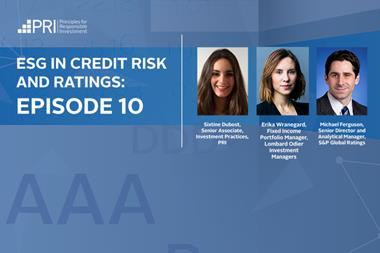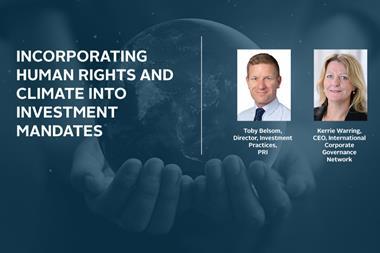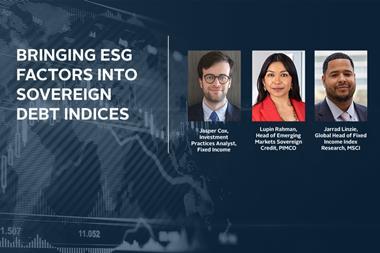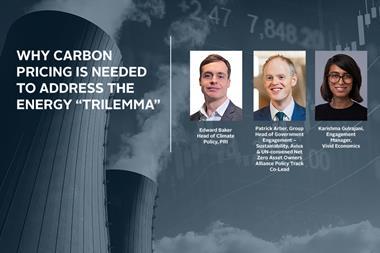Host Liz Barnes speaks with Habib Abdur-Rahman, Head of ESG at Investcorp, and Prudential’s Liza Jansen, Head of Responsible Investment at Prudential, and member of the UN-Convened Net-Zero Asset Owner Alliance.
With just a week to go until the highly-anticipated climate conference, they discuss their expectations for COP27, the role of investors in scaling up actions to deliver on a just transition to net zero, and how blended finance can be leveraged to mobilise capital into where finance is needed the most.
Find the transcript here.
Liz Barnes
Hello and welcome to the PRI podcast and the first in our spotlight episodes around COP 27. I’m Liz Barnes and I’m delighted to be your host for these special episodes. Every region of the world has seen climate change, wreaking havoc, creating huge social economic and financial losses, and this is just at a 1.2 Celsius temperature rise. We’ve seen the spiralling impacts in the devastating floods in Pakistan, drought in Somalia, and lethal heat waves in Europe and North America. As we focus on COP 27 in delivering on ratcheted ambitions from governments and non-state actors, we know that the window of climate action is shrinking, and we need to act fast and go further. The case for implementing net zero policies today is clear and the solutions required to address the ongoing climate trilemma energy security, cost of living and climate crises are the same as those needed to achieve global long-term climate objectives. Investors have a leading role to play in this process from raising awareness of climate risks and opportunities and in mobilizing massive capital towards sustainable outcomes. The PRI and across the net zero climate initiatives it convenes, is prioritizing the need for bold accelerated action at COP 27, where governments and investors take swift and meaningful steps towards zero emissions goals.
Liz Barnes
Today I’m joined by Liza Jansen, Head of Responsible Investments at Prudential, a member of the UN convened net zero Asset Owner Alliance and Habib Abdur-Rahman, head of ESG AT Investcorp. We’ll be talking about expectations and how to scale up investor climate actions ahead of COP. Welcome Liza and Habib.
Liza Jansen
Thank you, Liz it’s great to be here.
Habib Abdur-Rahman
Thank you, Liz.
Liz Barnes
This year the UN Annual Climate Conference is taking place in Sharm El-Sheik ,Egypt, gathering from the outcomes of COP 26 and the challenges and opportunities that we continue to face in delivering on the Paris Agreement. What are your expectations for COP 27? Liza, let’s go to you first.
Liza Jansen
So, COP 26 has seen a lot of large commitments towards climate change, but what we really need at COP 27 are of course those commitments put into practice. There needs to be more attention towards emerging markets. They are responsible for two thirds of the emissions right now, even if you take out China, it’s more than one third of the carbon emissions. If we really want to meet the goals of the Paris Agreement, we need to make sure that the emerging markets transition. And at this point, there’s not enough finance flowing to emerging markets to make sure they can actually transition. For example, in the Paris agreements developed, markets have committed to provide climate finance of 100 billion per year, but they haven’t lived up to this expectation yet. Also on adaptation, the emerging markets are more vulnerable to climate change, so they’re also going to need more financing to guard themselves against the physical impacts of climate change. I think emerging markets both from an energy transition and from an adaptation perspective and need to be central in the discussions at COP 27.
Habib Abdur-Rahman
Just building on Liza’s answer there, I think she was absolutely correct in the challenges that the emerging markets face to decarbonize their economies. One of the biggest challenges is going to be in the implementation of low-carbon solutions across all sectors of the economy, but that needs to happen on accelerated basis, and it needs to happen in a way that doesn’t disrupt, but in fact supports the economic and social interests of people living in the region. I think what gives me real confidence, I’m sitting here today in the UAE is that countries in the region, like the UAE, for example, have shown an ability to really deliver on large scale transformational projects time and again.
Liz Barnes:
Could you shed some more light?
Habib Abdur-Rahman
Sure. I think firstly, it’s important to acknowledge that the impact of climate change is perhaps more pronounced in the region. Of course, the region is not one homogenous entity. You have all producing nations of the Gulf States you have for the event, and then you have the countries of North Africa all with their own challenges and their own problems to deal with. But I think on the whole temperatures in the region have been rising much faster than the world average. And we also know that the region is heavily dependent on food imports and there is a longstanding issue when it comes to water resource scarcity. And these of course, you know, are not new issues. I mean, many countries have long acknowledged the need to address these challenges, not only to enhance environmental protection and boost the participation of the private sector to drive innovation, but also to really help develop those cutting-edge technologies that are needed to ultimately conserve natural resources.
Habib Abdur-Rahman
If we look to what governments have been doing in the region as well, one of the great advances that we’ve seen particularly over the past few years are the publishing of government sustainability strategies. Really outlining in quite some detail the roadmap to transitioning to net zero. And the UAE recently announced that it had invested $50 billion in renewable energy projects across 40 countries with plans to double this over the next decade. And this not only highlights the country’s commitment to addressing environmental concerns at home, but also abroad given the crisis is of course a global one. The other things we’ve seen happening in the region, which I think are hugely encouraging are sovereign wealth funds and central banks in the region now incorporating top-down sustainability thinking in their processes. We’ve seen asset managers and investors in the region really accelerating the way they incorporate sustainability thinking into their investment practices.
Habib Abdur-Rahman
We’re also seeing increased sophistication in the way they’re doing that, which I think is reflective of an increasing understanding among investors of how to really derive value from the application of sustainability thinking in what they do. We’re also seeing important steps being taken, particularly in recent years around improving data disclosure standards. Stock exchanges across the entire region, the GCC as well as North Africa, are now beginning to issue detailed guidance on ESG standards, but also in many instances ESG related training for issuers on stock exchanges. And finally, we’re seeing an important advances in corporate governance codes across the region, which I think will only translate into better disclosures over time.
Liz Barnes
So, following on from that, Habib, what about the role of investors within this context? What can investors do to deliver on a just transition to net zero
Habib Abdur-Rahman
Investors in the first instance are ultimately providers of capital, and I think it’s capital that’s needed to scale existing technologies that can help towards a transition to net zero. But also in the development of new technologies as well as in the, in advancing the deployment of these technologies in the countries and regions that need them most. And at Invescorp, I think we’ve recognized that decarbonization will trigger the biggest capital reallocation since the second World War across all sectors and across all nations. And I think the shift to a low carbon economy will create entirely new industries and value chains within the next 5 to 15 years. The good news here is that we have the solutions needed to harbour missions by 2030. We also know that the sufficient global capital and liquidity to finance climate solutions. So, I think the role for investors here, particularly those with a long term mindset, is really to help accelerate the transition across a number of key sectors.
Habib Abdur-Rahman
Power generation is one such sector, and I think the story here may largely be told, and the focus really is about transitioning the traditional energy system to renewable energy sources or sources of energy. This isn’t going to happen overnight. There are multiple complex factors at play. We mustn’t forget the imperatives of the emerging markets, particularly when it comes to ensuring a fair and just transition. Power generation is only one sector, it’s an important sector. There are lots of opportunities for investors to step up and to deploy capital. If you look at food security, for example, a key issue faced by the region, and of course as we know, the impact of climate change on food production globally will directly impact the ability of countries in the region to secure their food needs for the future. The sector of agriculture becomes increasingly important. We’ve seen some really interesting companies operating in the agriculture space, particularly around alternative proteins, for example. Whilst there are lots of issues still at play with the underlying technologies associated with alternative proteins, we’ve seen a number of companies in this space demonstrate really strong commercial traction here.
Liza Jansen
Investors are low overlooking two important things, emerging markets financing, and the other one is transition finance. As Habib shared, what we really need is a lot of financing to go into the actual transition, what that means, investing in carbon intensive companies and help them transition away hopefully towards net zero. As investors, we have created frameworks and standards on what we call responsible investments to try to channel investments towards the energy transition, creating incentives to start investing in things that are already green. For example, green bonds, the use of proceeds for green bonds are supposed to go through things that are green. However, what that is doing is that it’s for some companies take a steel company or a cement company for which we don’t have those net zero solutions yet it’s going be very difficult for them to issue those green bonds because this net zero steel doesn’t exist yet.
Liza Jansen
So, they can’t issue a bond that’s going to go towards that topic. And this has been overlooked in the frameworks that we’ve set as investors, the actual companies that need the most financing out of the most carbon intensive ones. So, if you actively want to invest in a transition, the carbon footprint of your portfolio will go up in the short term. The same is true unfortunately for emerging markets. A lot of companies in emerging markets are more carbon intensive than those companies in developed markets. So, the easiest way to decarbonize your investment portfolio, a global investment portfolio is to shift assets from emerging markets to developed markets. This is very useful to decarbonize your portfolio on paper, but will not have much effect in reality because the emerging markets are actually the ones that need most financing. The Paris agreement is built upon this principle, which is called the common but differentiated responsibilities in which we say the developed markets have more responsibility to act on climate change than other markets which have contributed less towards the problem. We haven’t translated this into any of our frameworks.
Liz Barnes
So, Liza, we’ve discussed a little bit about the focus on emerging markets already and this certainly includes the need to finance the transition. Prudential is part of the UN convened net zero asset owner reliance who recently just released its second progress report and published a call to action to governments on scaling blended finance. Liza, can you tell us a bit about blended finance? I mean, can you start by explaining what it is?
Liza Jansen
Blended finance is basically the use of concession capital to capital, usually coming from philanthropic organizations or multilateral development banks to mobilize private capital. So, capital from institutional investors. We are an institutional investor, and we have a fiduciary duty to act in the best interest of our policyholder. So, we need a decent return against a decent risk. The problem with a lot of investments in emerging markets is that those investments are too risky. So, you can use concession finance to de-risk these type of investments. This is probably going to be essential to make sure the emerging markets transition because the big pool of money in the world from institutional investors won’t be able to find its way towards emerging markets. The projects that we need to finance in emerging markets are just too risky. So that’s where blended finance comes in.
Liz Barnes
How is it an important financing tool? Why is it so relevant in the run up to COP 27?
Liza Jansen
The Net Zero Asset on Alliance just published the call to action and that really focuses on three points. If we think about blended finance, we need to think at a much larger scale. So, we’ve been talking about blended finance for a while and usually it’s funding projects. So, this is something we do as Prudential as well. We try to get a guarantee on a bond so we can fund a specific solar project, for example. However, financing and a project-by-project basis will take a very, very long time. One of our investments we have done was 13 million, which is great investment to us, but the current investment gap is 1 trillion at this rate. And the amount of time it takes us to do due diligence will not be done in 300 years, probably. We should look at multilateral development banks so they can modernize their own business model to make sure that they’re actually crowding in more capital from institutional investors instead of financing the projects by themselves. One way to crowd in this capital is by de-risking the investments, for example, a multilateral development bank can put on a guarantee on a fund or a project, making sure that we as an institutional investor can invest.
Liz Barnes
And Habib, what are your views on this?
Habib Abdur-Rahman
Liza spoke about some hard to abate sectors such as steel for example, and the fact that technologies today don’t exist to the extent that perhaps they exist in other sectors that allow those sectors to decarbonize at a faster rate. And I think here the role of blended finance is important. I mean, to the extent that blended finance can successfully bring together public institutions and private capital to really mobilize financing for projects that are only marginally bankable. I think this will be key to accelerating the adoption of technologies that support the decarbonization of those hard to abate sectors. At the same time, I think the public sector can also provide seed capital or grant financing to help companies to really build those feasibility studies and those proofs of concepts that are required particularly in those sectors that are today underfunded. Such as, for example, clean energy access or early stage adaptation technologies, nature-based solutions and so on and so forth. And Liza spoke also about guarantees. Can the public sector actually offer a first loss guarantees or to provide credit enhancement to lower risk to private sector investors? I think those are very important questions that we need to address. And it’s clear that a comprehensive approach to not only climate policy but climate finance is needed. And clearly, I think blended finance could be used as a vehicle to really incentivize but also catalyse private sector contribution to bridge the funding gaps that I think exist today.
Liz Barnes
Well, it sounds like there’s an incredible amount to think about that. Liza, you wanted to make another point?
Liza Jansen
Yes. Just to mention on a bit more positive tone, blended finance, I mean it’s been around for a while already and we’ve seen a lot of different kind of initiatives within blended finance. We just need to take the good ideas and see how we can scale them, which is definitely much easier than starting from scratch. So, I think the role is there and the good ideas are there. Just think about how we can scale.
Liz Barnes
It certainly sounds like there’s a lot to do. It is almost time for us to go. But one thing I would like to do is ask you both what you would like to see personally coming out of COP Habib, may I come to you first?
Habib Abdur-Rahman
I’m hugely optimistic about what’s ultimately achievable. If we leverage the power of the private sector, the public sector of politics, of finance, to really tackle the huge problems that we see in front of us. People often ask me why I’m so optimistic. I think my answer really is simple optimism is really the only thing that will give us a fighting chance to tackle the problems that really impact us all. You know, coming out of COP 26, we saw a lot of talk about climate adaptation and the need for support for an emerging markets and for emerging economies. And so, I think coming out of COP 27, one of the things that I’d really like to see is that climate adaptation and these are, this prefers specifically to actions that help to reduce the negative impact of climate change, how we respond to climate change. That climate adaptation support is for the most vulnerable countries, and of course the most vulnerable people, not only within those vulnerable countries, but across the world who oftentimes bear the brunt of some of the most devastating climate events that we see.
Liza Jansen
So, this is just my personal view, but I’m from the Netherlands and unfortunately the Netherlands is within the European Union lagging on renewable energy about the same time. Netherlands have been part of the top 10 most richest countries in the world for very long time. So, what I would like to see out of COP is more leading by example from the countries that can actually afford to raise a lot of financing for the energy transition. And they have a lot more access to finance. If you think about the Netherlands, the windmill is really the icon of Dutch culture, and yet our share of renewable energy is among the lowest within the European Union, which makes me a little bit sad, especially if you think about the all the other challenges that we are already facing.
Liz Barnes
Well, Liza, thank you so much for your input and also Habib as well, thank you for your views and your input. It’s been a pleasure to talk to both of you today. And I thank you for your expertise. You can access all the resources we discussed in the episode description. Stay tuned also for our next COP 27 special episode where we’ll be looking at key outcomes from the conference. And if you like this episode, please do rate, and follow the PRI podcast. And for more information on responsible investment, visit https://www.unpri.org/.
Downloads
Spotlight on COP27
PDF, Size 0.21 mb

















